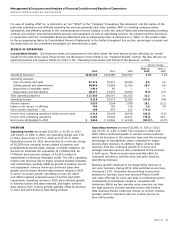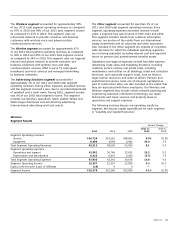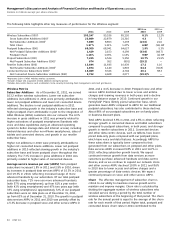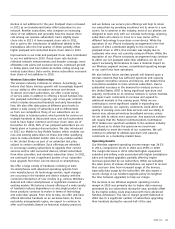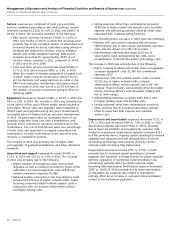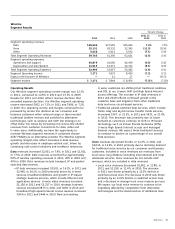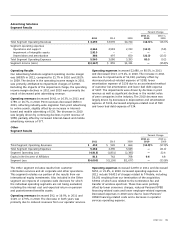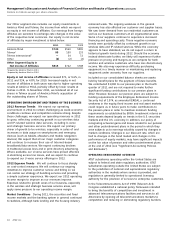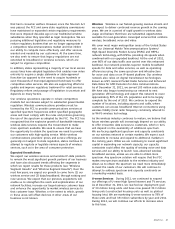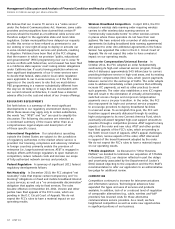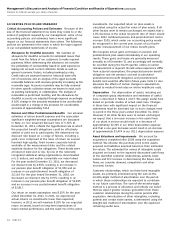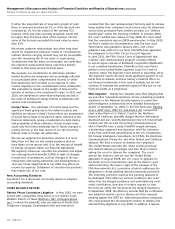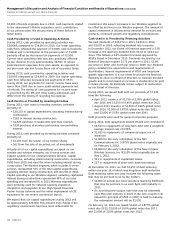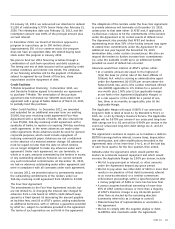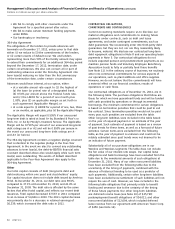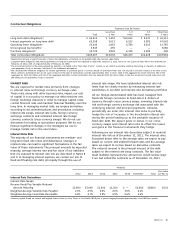AT&T Wireless 2011 Annual Report Download - page 43
Download and view the complete annual report
Please find page 43 of the 2011 AT&T Wireless annual report below. You can navigate through the pages in the report by either clicking on the pages listed below, or by using the keyword search tool below to find specific information within the annual report.
AT&T Inc. 41
Wireless Wireless is our fastest-growing revenue stream and
we expect to deliver continued revenue growth in the coming
years. We are in a period of rapid growth in wireless data
usage and believe that there are substantial opportunities
available for next-generation converged services that combine
wireless, broadband, voice and video.
We cover most major metropolitan areas of the United States
with our Universal Mobile Telecommunications System/
High-Speed Downlink Packet Access (HSPA) and HSPA+
network technology, with HSPA+ providing 4G speeds when
combined with our upgraded backhaul. At the end of 2011,
over 80% of our data traffic was carried over this enhanced
backhaul. Our network provides superior mobile broadband
speeds for data and video services, as well as operating
efficiencies using the same spectrum and infrastructure
for voice and data on an IP-based platform. Our wireless
network also relies on digital transmission technologies
known as GSM, General Packet Radio Services and Enhanced
Data Rates for GSM Evolution for data communications.
As of December 31, 2011, we served 103 million subscribers.
We have also begun transitioning our network to next
generation LTE technology and expect this network to cover
approximately 80% of the U.S. population and to be largely
complete by the end of 2013. We continue to expand the
number of locations, including airports and cafés, where
customers can access broadband Internet connections using
wireless fidelity (local radio frequency commonly referred to
as Wi-Fi) wireless technology.
As the wireless industry continues to mature, we believe that
future wireless growth will increasingly depend on our ability
to offer innovative data services to customers, which in turn,
will depend on the availability of additional spectrum.
We are facing significant spectrum and capacity constraints
on our wireless network in certain markets. We expect such
constraints to increase and expand to additional markets in
the coming years. While we are continuing to invest significant
capital in expanding our network capacity, our capacity
constraints could affect the quality of existing voice and data
services and our ability to launch new, advanced wireless
broadband services, unless we are able to obtain more
spectrum. Any spectrum solution will require that the FCC
makes new spectrum available to the wireless industry and
allows us to obtain the spectrum we need more immediately
to meet the needs of our customers. We will continue to
attempt to address spectrum and capacity constraints on
a market-by-market basis.
U-verse Services During 2011, we continued to expand
our offerings of U-verse High Speed Internet and TV services.
As of December 31, 2011, we reached our deployment goal
of 30 million living units and have now passed 30.3 million
living units (constructed housing units as well as platted
housing lots). We are marketing U-verse services to 78% of
those units and had 3.8 million subscribers by year-end 2011.
During 2012, we will continue our efforts to increase sales
to this base.
that harm consumer welfare. However, since the Telecom Act
was passed, the FCC and some state regulatory commissions
have maintained or expanded certain regulatory requirements
that were imposed decades ago on our traditional wireline
subsidiaries when they operated as legal monopolies. We are
pursuing additional legislative and regulatory measures to
reduce regulatory burdens that are no longer appropriate in
a competitive telecommunications market and that inhibit
our ability to compete more effectively and offer services
wanted and needed by our customers. At the same time,
we also seek to ensure that legacy regulations are not
extended to broadband or wireless services, which are
subject to vigorous competition.
In addition, states representing a majority of our local service
access lines have adopted legislation that enables new video
entrants to acquire a single statewide or state-approved
franchise (as opposed to the need to acquire hundreds or
even thousands of municipal-approved franchises) to offer
competitive video services. We also are supporting efforts to
update and improve regulatory treatment for retail services.
Regulatory reform and passage of legislation is uncertain and
depends on many factors.
Our wireless operations operate in robust competitive
markets but are likewise subject to substantial governmental
regulation. Wireless communications providers must be
licensed by the FCC to provide communications services at
specified spectrum frequencies within specified geographic
areas and must comply with the rules and policies governing
the use of the spectrum as adopted by the FCC. The FCC has
recognized that the explosive growth of bandwidth-intensive
wireless data services requires the Government to make
more spectrum available. We seek to ensure that we have
the opportunity to obtain the spectrum we need to provide
our customers with high-quality service. While wireless
communications providers’ prices and service offerings are
generally not subject to state regulation, states continue to
attempt to regulate or legislate various aspects of wireless
services, such as in the area of consumer protection.
Expected Growth Areas
We expect our wireless services and wireline IP-data products
to remain the most significant growth portions of our business
and have also discussed trends affecting the segments in
which we report results for these products (see “Wireless
Segment Results” and “Wireline Segment Results”). Over the
next few years, we expect our growth to come from: (1) our
wireless service and (2) data/broadband, through existing and
new services. We expect that our previous acquisitions will
enable us to strengthen the reach and sophistication of our
network facilities, increase our large-business customer base
and enhance the opportunity to market wireless services to
that customer base. Whether, or the extent to which, growth
in these areas will offset declines in other areas of our
business is not known.


